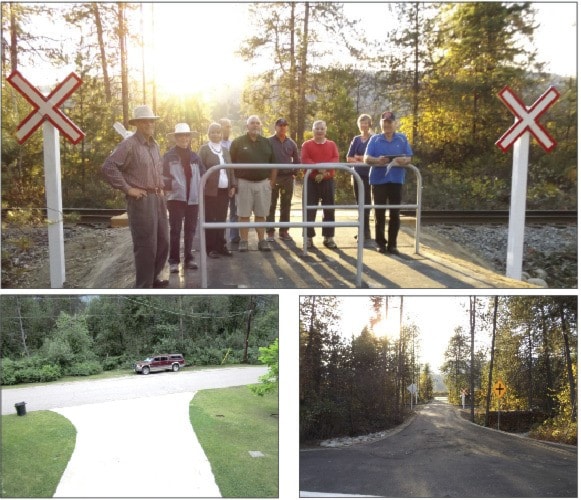With the Connors Road Pedestrian/Cyclist Pathway project nearing completion, neighborhood residents are still upset with the city over the way the project has been handled, and with the finished product.
A group of 10 home owners from the area recently met with the Castlegar News to express their frustrations.
The group was led by John Shirley, whose property is directly across from the point in the pathway that crosses the railroad tracks. The Shirleys previously had a view from their home that consisted of trees and vegetation. That view now includes railroad tracks, vehicles on the highway off ramp and in the distance, the neon sign of the Sandman Hotel.
The neighborhood residents feel that the project has been rushed and that not enough consultation was done with those who would be affected by the pathway.
One cited example was that after John Phillips made a presentation at a city council meeting about the concerns and requested city council to meet with residents they were only given two days notice that a meeting would take place.
Also frustrating was that the meeting would take place with Chris Barlow, director of transportation and civic works, rather than with city councillors. The residents did acknowledge that they had received a letter in 2012 explaining the project and stating it would take place in 2013. When the project did not go ahead in 2013, the residents assumed it must have been canceled.
Another source of contention is that the point where the pathway leaves Connors Road and crosses the railroad tracks was changed from the plans that the residents were previously shown.
Nesta Hale expressed her feelings, “We strongly object to the way this was done, with the contractor allowed by the city to position it differently than we were told. The city should have been on site.”
They had also hoped the plans could be altered so the pathway could be constructed at an angle to reduce the impact on any one residence.
Since some residents feel their property values have been decreased, this is an emotional issue for them. Elizabeth Fleet stated, “The only realistic way to compensate for the loss of value to the Shirleys is the removal of the pathway and reforestation.”
They wonder, why was a pathway even needed?
The residents also have concerns over safety issues. They feel the crossing is located too close to a curve in the tracks causing reduced visibility. Vehicles driving in the pathway along Connors Road is another concern.
The list of complaints goes on to include increased noise cause by traffic and train whistles, removal of more vegetation than necessary, the narrowing of their road and receiving misinformation.
John Shirley declared, “As far as I am concerned, the city lied to us.”
When asked what they would like to accomplish, the consensus involved two things: they would like to see Mayor and Council talk to them with an open mind but, ideally, they would like to see the project torn out and the area reforested.
Barlow was given the opportunity to present the city’s side of the issue. He showed a chronology of the project. In 2008 the city prepared a Pedestrian and Cycling Master Plan. The Connors Road project was included in that plan. The city then began to set aside $50,000 in each year’s annual budget to pay for the project.
The design was put together in 2012 and the city applied for a grant to help pay for the project. In August 2012, letters containing design plans were hand delivered to residents with properties adjacent to the pathway.
Only one resident officially contacted civic works with concerns. The city did not get the grant on the first try, so the project was postponed until they received a grant in June 2014. The project then went out to tender in August.
The reason given for some of the design elements the residents are unhappy about was that it was to meet requirements of CP Rail.
CP Rail required that the crossing be located halfway between the curve by Century 21 and the rail bridge. The railroad also required the crossing to be perpendicular to the tracks. After considering the option of making the pathway at an angle, due to the actual crossing needing to be perpendicular, it was decided that the best way to build with the least vegetation damage was to put the pathway in with a 90 degree turn according to the original plans.
During construction, the original entrance was moved.
The decision was made to relocate it from an area where there were large trees to a spot where there was a dead tree that needed to be removed for safety reasons anyway.
Barlow stated, “We did everything we could to preserve vegetation. The contractor was very aware of the need to preserve as much vegetation as possible.”
After the original vegetation removal, CP Rail then removed some additional vegetation to improve their line of sight of the crossing.
Barlow explained, “The overall goal of the Pedestrian Cycling Master Plan is to link all of the different communities within the city together into one safe bicycle and pedestrian pathway system.”
The Connors Road pathway is an important link in that plan as it will be the link connecting the north and south end together and bypass the interchange area which contains the busiest intersection in the city.
“Unfortunately it has impacted some properties, but for the good of the whole city’s overall plan it was an important link,” Barlow concluded.
